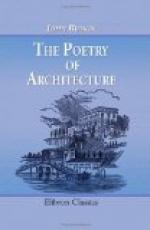[Footnote 32: Actually carved on one of the groins of Roslin Chapel.]
[Illustration: Fig. 12. Old English Mansion. 1837.]
169. This is no exaggeration: we have not only listened to speculations on the probable degree of the future majesty, but contemplated the actual illustrious existence, of several such buildings, with sufficient beauty in the management of some of their features to show that an architect had superintended them, and sufficient taste in their interior economy to prove that a refined intellect had projected them; and had projected a Vandalism, only because fancy had been followed instead of judgment; with as much nonchalance as is evinced by a perfect poet, who is extemporizing doggerel for a baby; full of brilliant points, which he cannot help, and jumbled into confusion, for which he does not care.
170. Such are the first difficulties to be encountered in villa designs. They must always continue to occur in some degree, though they might be met with ease by a determination on the part of professional men to give no assistance whatever, beyond the mere superintendence of construction, unless they be permitted to take the whole exterior design into their own hands, merely receiving broad instructions respecting the style (and not attending to them unless they like). They should not make out the smallest detail, unless they were answerable for the whole. In this case, gentlemen architects would be thrown so utterly on their own resources, that, unless those resources were adequate, they would be obliged to surrender the task into more practiced hands; and, if they were adequate, if the amateur had paid so much attention to the art as to be capable of giving the design perfectly, it is probable he would not erect anything strikingly abominable.
171. Such a system (supposing that it could be carried fully into effect, and that there were no such animals as sentimental stone-masons to give technical assistance) might, at first, seem rather an encroachment on the liberty of the subject, inasmuch as it would prevent people from indulging their edificatorial fancies, unless they knew something about the matter, or, as the sufferers would probably complain, from doing what they liked with their own. But the mistake would evidently lie in their supposing, as people too frequently do, that the outside of their house is their own, and that they have a perfect right therein to make fools of themselves in any manner, and to any extent, they may think proper. This is quite true in the case of interiors; every one has an indisputable right to hold himself up as a laughing-stock to the whole circle of his friends and acquaintances, and to consult his own private asinine comfort by every piece of absurdity which can in any degree contribute to the same; but no one has any right to exhibit his imbecilities at other people’s expense, or to claim the public pity by inflicting




